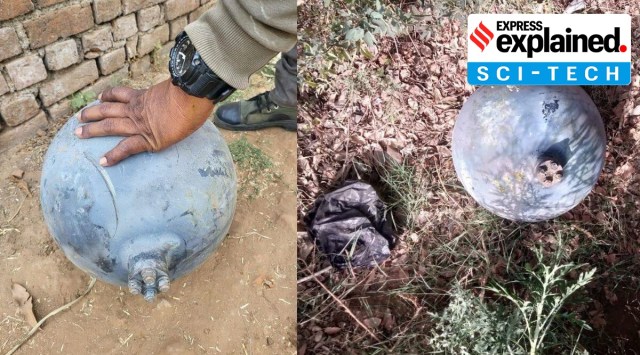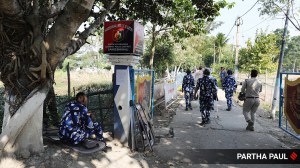- India
- International
Explained: What do we know about the debris that ‘fell from the sky’ in Gujarat?
On May 12, villagers in Gujarat got confused and curious as fragments of suspected debris "fell from space" at three locations — Bhalej, Khambholaj, and Rampura. What do we know about the debris?
 The debris found in Gujarat's villages. (Express photo)
The debris found in Gujarat's villages. (Express photo)On May 12, villagers in Gujarat remained confused and curious as fragments of suspected debris “fell from space” at three locations — Bhalej, Khambholaj, and Rampura.
As a team from the Forensic Science Laboratory probes the debris, we take a look as to what has been found so far, how it is different from the debris from meteoroids and whether there have been similar incidents in the past in India.
What do we know about the debris?
According to the local police, at around 4.45 pm on May 12, “the first large, black metal ball” weighing around five kilograms fell “from the sky” in Bhalej village in Anand, followed by two similar fragments at two other villages — Khambholaj and Rampura. The three villages are located within a 15-kilometre radius, with one piece of the debris falling in Chimanbhai’s field. Luckily, no one was injured, the authorities informed.
On May 14, similar sphere-shaped debris was reported at Chaklasi village in Anand, about 8 km away from Bhalej.

While Indian authorities have not issued any statement ascertaining what it might be, astronomer Jonathan McDowell at the Harvard Smithsonian Center for Astrophysics tweeted that it could possibly be debris from the re-entry of the Chang Zheng 3B serial Y86 — China’s orbital launch vehicle.
Responding to a query by The Indian Express, McDowell said that his deduction is based on the fact that this object “is the only re-entry that day (May 12) that went anywhere near India,” based on data from the US Space Force that he monitors.
Aerospace.org also predicted the same, saying that the launch vehicle will re-enter the Earth’s space on May 12 at around 10.37 am (IST).
However, McDowell adds that “the predicted path was a few hundred km north of the villages in question, but that’s within the uncertainties for this particular object since its orbit was more uncertain than usual”.
“The problem is that the orbit was rapidly changing due to atmospheric drag. So, the last Space Force Orbit we had was several hours old. The projection forward of that orbit is reliable in terms of its path through space. But the position of the rocket along its track is uncertain, and you have to take into account that if it’s five minutes late, the Earth has turned underneath the orbit by 5 minutes, which is equal to 0.25 degrees in that said amount of time. As such, the predicted ground location also changes accordingly,” McDowell said.
Gujarat’s Anand district collector M Y Daxini stated that a Forensic Sciences Laboratory team is examining the samples and that the district collectorate is “in touch with” Physical Research Laboratory, Ahmedabad, and Indian Space Research Organisation’s (ISRO) Space Application Centre (SAC) to determine if the debris is from a satellite or a rocket.
The third stage from the Chang Zheng 3C serial Y86 rocket, which launched the ZX-9B communications satellite in Sep 2021, reentered today sometime around 0900-1200 UTC. (1/2)
— Jonathan McDowell (@planet4589) May 12, 2022
What is space debris?
Space debris can include natural space debris such as meteoroids, or man-made ones which can include defunct spacecrafts and satellites, stages of rockets which have launched payloads, dead satellites, satellite explosions and collisions.
According to NASA, “more than 25,000 objects larger than 10 cm are known to exist” as space debris and the estimated population of particles between 1 and 10 cm in diameter is approximately 500,000. According to NASA’s estimates, as of January 2022, the amount of material orbiting the Earth exceeded 9,000 metric tons.
What is Chang Zheng 3B serial Y86, from where the debris is suspected to have fallen?
Chang Zheng 3B, commonly known as CZ 3B, is China’s orbital launch vehicle, similar to India’s GSLV or PSLV. ‘Long March’ rockets are a family of carrier rockets operated by the China National Space Administration, which carry the satellites or payloads. The 3B denotes the Long March 3B model in this family of rockets.
The model has conducted as many as 84 flights, the last being in April 2022, carrying communications satellites. Y86 denotes the designated serial number of the 78th flight mission. This mission was launched on September 9, 2021, carrying the 5,500 kg ChinaSat 9B communication satellite to the geostationary transit orbit.
Usually, the first and second stage of rockets make it back to earth after take-off within a week or so because of the release of these stages at lower altitudes. In such cases, the re-entry can then be manoeuvred in such a way that they do not affect populated landmass and cause damage. However, the third stage, which releases the satellite at the required orbit following which it remains in sub-orbital flight, remains outside the purview of being controlled by human intervention and ultimately re-enters earth. It is this third stage of the Long March 3B Y 86 rocket launch that is now suspected to have re-entered earth, leading to debris falling in Gujarat.
The difference in impact made by a natural and man-made debris
Most pieces of space debris burn up as they enter the Earth’s atmosphere, the process starting from around a height of 100 km from Earth’s surface to 20 km. However, sometimes, very heavy pieces may not burn completely, and some part of the object may make it down to the surface, either hitting a landmass or a waterbody.
Notably, with constellation satellites gaining traction such as SpaceX’s Starlink project, OneWeb Constellation by London-based OneWeb and Project Kuiper of Amazon, the common criticism has been the increase in space debris and the risk of collision.
In cases of man-made debris, it often disintegrates into fragments, thus hardly ever creating large-scale impact. It is usually natural debris, such as asteroids and meteoroids, that cause relatively large-scale craters, if it ends up hitting a landmass.
How does space debris move and how are they tracked?
Tracking space debris has become an area of interest for many astronomers. NASA, for example, says that “large orbital debris (> 10 cm) is tracked routinely by the US Space Surveillance Network” as objects as small as 3 mm can be detected by ground-based radars, “providing a basis for a statistical estimate of their numbers”.
In the lower parts of Earth’s orbit (below 2,000 km), debris circles the Earth at speeds of about 7-8 km per second. However, the average impact speed of orbital debris with another space object is approximately 10km/s, and can go up to about 15 km/s, which is about 10 times the speed of a bullet. Consequently, collisions with even a small piece of debris will involve considerable energy.
Assessments of the population of orbital debris smaller than 1 mm can be made by examining impact features on the surfaces of returned spacecraft, although this has been limited to those operating in altitudes below 600 km. According to NASA Orbital Debris Programme Office, “The intentional destruction of the Fengyun-1C weather satellite by China in 2007, and the accidental collision of the American communications satellite, Iridium-33, and the retired Russian spacecraft, Cosmos-2251, in 2009 greatly increased the number of large debris in the orbit — represent one-third of all catalogued orbital debris.
Have there been similar incidents in the past?
In India, a similar event was reported in April this year when six metallic balls and a metal ring, also suspected to be from China’s Long March 3B rocket, fell from the sky in parts of Maharashtra and Madhya Pradesh. A team from ISRO was roped in to determine the specific nature of it.
McDowell told The Indian Express that the third-stage re-entries over populated areas occur “once every few months”.
An event that stands out in terms of the damage caused by space debris is one from February 1996. A Long March 3B rocket launch failure resulted in debris from the satellite’s payload, US-made Intelsat 708, falling from the sky minutes after the lift off, which reportedly killed six and injured 57 others in China, according to news agency Xinhua. The first reported incident of damage from space debris was in 1978 after the crash of the then USSR’s nuclear-powered Cosmos 954 satellite, which fell over Canada nearly four months after the take-off, requiring extensive clean-up of radioactive material.
Under the Convention on International Liability for Damage Caused by Space Objects, countries can claim compensation from other countries for damages incurred from space debris.
Newsletter | Click to get the day’s best explainers in your inbox
More Explained
EXPRESS OPINION
Apr 25: Latest News
- 01
- 02
- 03
- 04
- 05









































